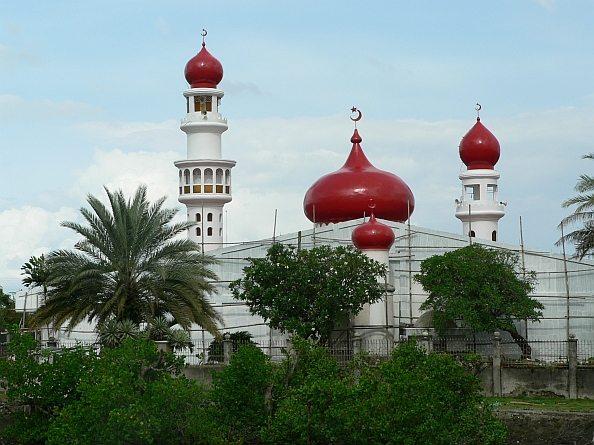---------------------------------------
Another example of the unusual architecture in this part of the country.

---------------------------------------
Zamboanga is well off the tourist circuit and, as such, proved difficult for me to move around inconspicuously. In my weekend in the province, I never saw another white person. Hundreds of eyes followed my every move, which can get unsettling over time. My coworkers warned me away from the province, saying it was an Abu Sayef stronghold; that certainly would explain the dearth of tourists. But from what I had gleaned from my research, the terror attacks seemed confined to the countryside and offshore islands. Zamboanga City was reported to be safe, so I didn't feel like I was taking any inordinate risks by visiting there.
Those who speak Spanish will find that they can read and understand a lot of what they hear in Zamboanga, for the local language is a mixture of Malay grammar and Spanish words. The city bills itself as "Asia's Latin City" as the "bienvenidos" poster greeting arrivals at the airport shows.
---------------------------------------
Another example of the unusual architecture in this part of the country.

---------------------------------------
Ft Pilar, downtown Zamboanga. Built by the Spanish in 1635 and changed hands several times in subsequent centuries, it didn't revert to Filipino control until after WWII when the Japanese were driven out of the country.



---------------------------------------
The Tomb of the Unknown Soldier, north of the city. A gigantic army helmet flanked by two large guns. Under the helmet is a plaque that commemorates the unknown soldiers who have given their lives in defense of the country.

---------------------------------------
Just up the road from the tomb lies �Freedom�s Eternal Shrine�, showing a mortally wounded Ninoy Aquino in his final dying moments after President Ferdinand Marcos had him gunned down in 1983.

---------------------------------------
Zamboanga was definitely grittier and dirtier than other areas of the Philippines I had visited, and evidence of poverty was more pronounced. Still, in the midst of an area that is 70% Muslim and supposedly a threat to Western visitors, it was nice to see some evidence of appreciation for the USA. The American flag painted on the back of this tricycle caught me by pleasant surprise.

---------------------------------------
As so often happens when I visit a place I know almost nothing about, I get ideas of where to visit from the air; this is why I almost always try to secure a window seat when flying to a destination for the first time. This proved to be quite a treasure trove for Zamboanga, for I would not have known about the magnificent red mosque at Taluksangay had I not seen a glimpse of it from the plane. Even though it lies some distance east of the city, I knew I could not leave Zamboanga without seeing it up close.




---------------------------------------
The closest I got to Abu Sayef, the island of Basilan strikes a seductive pose on the horizon. The Sulu Archipelago is rated as a strict no-go area for tourists, underscored by the kidnapping of two Westerners on the island one week before I arrived. It was one caution I was only too happy to heed. I thought about hiring a boat out to Great Santa Cruz Island (foreground) to see its famous pink sand beach, but decided to stick to the safety of viewing these islands from the shoreline instead.

Click [here] to read my Zamboanga journal!